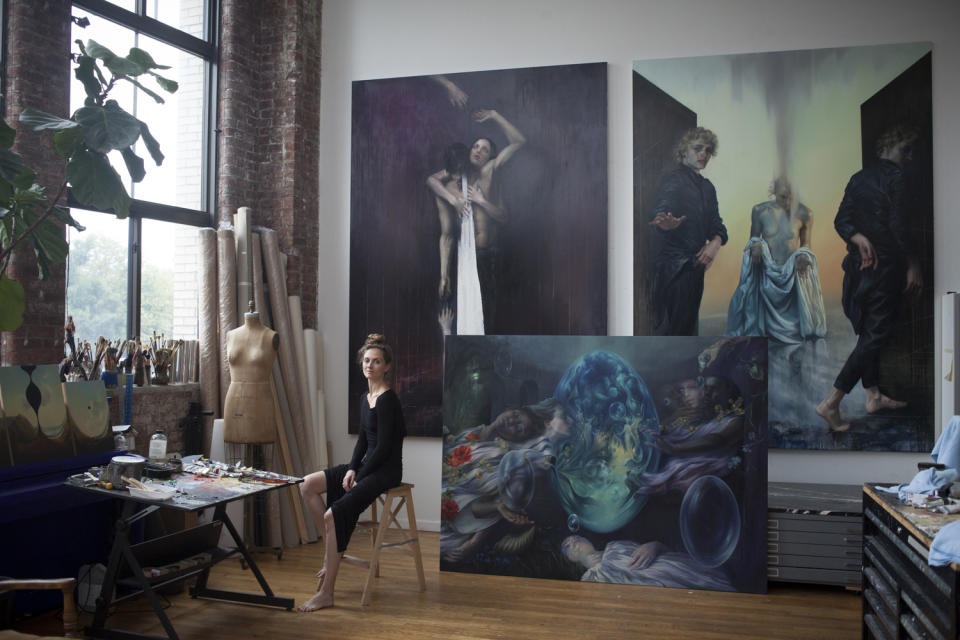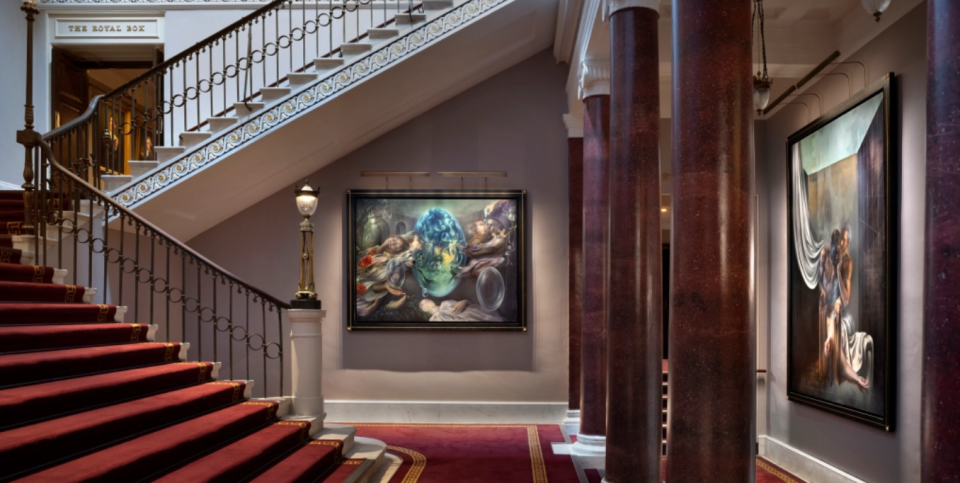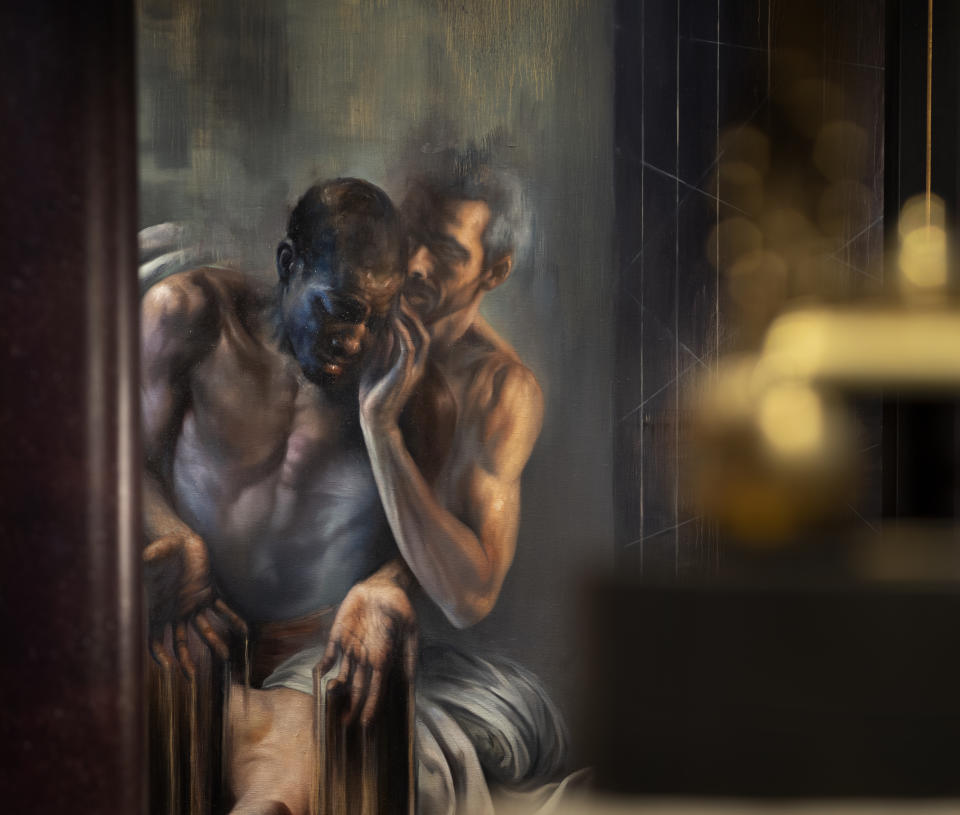Maria Kreyn Tapped by Andrew Lloyd Webber for Theatre Royal Drury Lane Renovation in West End

After a year-and-a half spent working in close quarters, Maria Kreyn was ready to say goodbye to her quarantine pod. After a brief period of separation, the Brooklyn, N.Y.-based artist was reunited in London with the cast of characters she’d spent months living with in her studio in Red Hook. There they were on the walls of the renovated Theatre Royal Drury Lane: Romeo and Juliet, Lady Macbeth, Othello and Hamlet.
“I was living with all of these dynamic, interesting characters in one zone for a very long time,” says Kreyn. “And then once they left [the studio], I was like, ‘oh, wow — I exist.’”
More from WWD
A Preview of 'Kusama: Cosmic Nature' at the New York Botanical Garden
Inside Robert Nava's 'Angels' Exhibition at Vito Schnabel Gallery
The artist, who’s in her mid-30s, had been commissioned by Lord Andrew Lloyd Webber in late 2019 to create a series of eight large-scale paintings for the renovation of his West End theater. After a year and a half, the paintings are now permanently installed in the theater’s impressive entrance.

Courtesy

Lloyd Webber reached out to the artist about the collaboration after seeing a feature on her work in Vanity Fair. A fan of pre-Raphaelite art, he was drawn to a similar aesthetic quality within Kreyn’s contemporary work. “It was effectively a cold call and he said that he urgently needed to speak with me about a project,” says Kreyn.
She jumped at the opportunity to make a body of work permanently installed in a historic space for the performing arts. “Because you end up speaking through your work with thousands and thousands of people into the future, who you will never be able to meet, but who you can touch in some way,” she says. (“Frozen” is currently in residence at the theater, which means she’s also touching an audience that skews younger.)
Kreyn flew out to meet Lloyd Webber in the London theater, which at the time was a “bona fide construction zone.” Afterward, he visited Kreyn’s studio, where the idea of creating work inspired by Shakespeare emerged when he spotted a painting she’d made that resembled a contemporary Ophelia. His prompt for Kreyn was as follows: “I’d like you to make this work dangerous and apocalyptic, with your soul on the line,” she recalls.
The prompt took on new urgency during the pandemic and the artist leaned into the range of human emotion embedded in Shakespeare’s work, ranging from the pleasant to the apocalyptic. The drama also extends to the external elements, like the epic nature of weather within “The Tempest.”
Kreyn found that the work resonated with what was happening outside of her studio window.
“I don’t think we’ve ever had a moment where globally, we were all pondering and reckoning with one very specific thing that wasn’t a personal drama,” she says. “It was a wild moment — and not in a pleasant way. Shakespeare wrote ‘King Lear’ and ‘Macbeth’ in quarantine during the bubonic plague. And so, you know, there was that parallel as well.”
After meeting with Shakespearean scholar and famed theater director Sir Trevor Nunn early in her process, Kreyn chose eight of Shakespeare’s best-known plays to depict in her work: “King Lear,” “Othello,” “Romeo and Juliet,” “Macbeth,” “As You Like It,” “A Midsummer Night’s Dream,” “Hamlet” and “The Tempest.” “I figured I would be in a better position to be in dialogue with those in a deeper way than if I just grabbed something that I hadn’t been familiar with,” says Kreyn, who also consulted with her friend Bill Barclay, the former music director of the Globe theater.

Courtesy of Philip Vile

<img class="size-full wp-image-1234930276" src="https://wwd.com/wp-content/uploads/2021/09/Screen-Shot-2021-09-17-at-2.51.27-PM.png" alt="." width="1024" height="1170" srcset="https://wwd.com/wp-content/uploads/2021/09/Screen-Shot-2021-09-17-at-2.51.27-PM.png 1094w, https://wwd.com/wp-content/uploads/2021/09/Screen-Shot-2021-09-17-at-2.51.27-PM.png?resize=131,150 131w, https://wwd.com/wp-content/uploads/2021/09/Screen-Shot-2021-09-17-at-2.51.27-PM.png?resize=263,300 263w" sizes="(min-width: 87.5rem) 1000px, (min-width: 78.75rem) 681px, (min-width: 48rem) 450px, (max-width: 48rem) 250px" />
The artist put herself on a “media diet” so her depictions wouldn’t be affected by pop culture portrayals of the characters; she wanted to source her imagery directly from the text. Her painting process was rooted in the theatrical quality of the works, and she often found herself acting out the plays and drawing gestures out of the physicality of the writing. “I wanted to see what would come out from my intellectual pressure cooker,” she says.
Her depiction of “The Tempest” proved most challenging, but that piece has also informed her art going forward. Kreyn is in the middle of developing a personal series inspired by the idea of storms.
“The world is going through its sort of storm, and I feel internally I’ve been going through my storms. It’s an autobiographical process and it has immense resonance with what I think is happening externally,” she says. “In the same way that I’m meandering through life, I’m meandering through my work. It’s like a continuous daydream.”
Kreyn is self-taught and immersed herself in painting after studying math and philosophy as an undergraduate at the University of Chicago. While she’s left math behind, that framework of thinking can be read within her paintings.
“What I’m doing is chaotic and nonlinear. And yet I would say that being good at math requires you to be very intuitive, which also is kind of like a dream logic,” she says, adding that she was studying math as “a hobby.”
“But I would say that every mode of thinking informs what I do. I have a pretty solid analytic component to my painting practice. But at this point, it runs on intuition. I’ll do a certain amount of research, and I love using texts and literature as a point of departure. Then after that, I let it all go and see what the flow state turns out.”
<img class="size-large wp-image-1234929562" src="https://wwd.com/wp-content/uploads/2021/09/Andrew-Lloyd-Webber-x-Maria-Kreyn-Commission-in-situ-1-LOBBY-A-photo-by-Philip-Vile.jpeg?w=1024" alt=". - Credit: Courtesy of Philip Vile" width="1024" height="792" srcset="https://wwd.com/wp-content/uploads/2021/09/Andrew-Lloyd-Webber-x-Maria-Kreyn-Commission-in-situ-1-LOBBY-A-photo-by-Philip-Vile.jpeg?w=2048 11711w, https://wwd.com/wp-content/uploads/2021/09/Andrew-Lloyd-Webber-x-Maria-Kreyn-Commission-in-situ-1-LOBBY-A-photo-by-Philip-Vile.jpeg?resize=150,116 150w, https://wwd.com/wp-content/uploads/2021/09/Andrew-Lloyd-Webber-x-Maria-Kreyn-Commission-in-situ-1-LOBBY-A-photo-by-Philip-Vile.jpeg?resize=300,232 300w" sizes="(min-width: 87.5rem) 1000px, (min-width: 78.75rem) 681px, (min-width: 48rem) 450px, (max-width: 48rem) 250px" />Courtesy of Philip Vile

Courtesy of Philip Vile

Courtesy of Philip Vile
More Art Coverage From WWD:
Christie’s to Auction Works From Designer Herbert Kasper’s Art Collection
Helmut Lang Celebrates Collaboration With Artist Maia Ruth Lee
Peter Saul Hasn’t Run Out of New Subjects to Paint
Best of WWD
Sign up for WWD's Newsletter. For the latest news, follow us on Twitter, Facebook, and Instagram.

